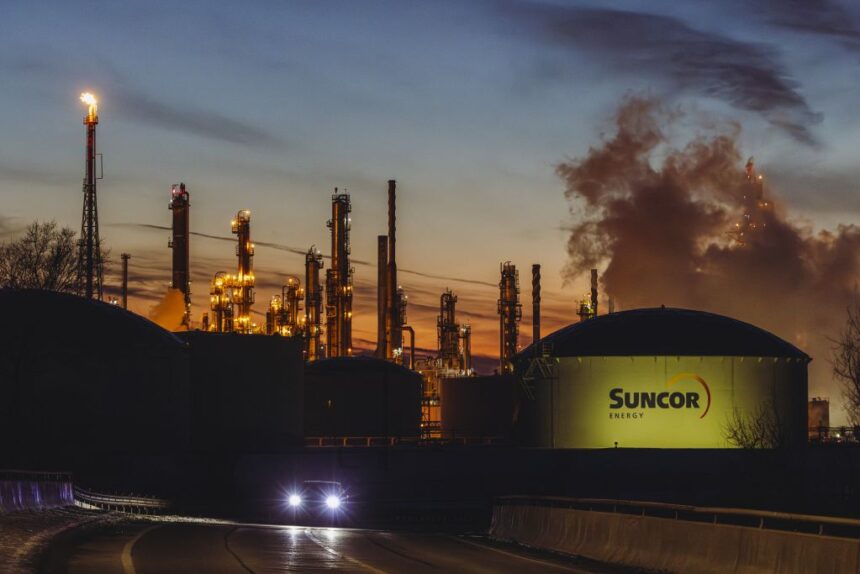Ontario’s associate minister of energy-intensive industries, Sam Oosterhoff, is impressed by Suncor Energy. The oil and gas company is producing about 100,000 barrels of oil products per day at its Sarnia, Ont., refinery, Oosterhoff told his colleagues at the legislature after visiting the plant in what’s known as Chemical Valley. They aren’t “cowboys” who don’t care about climate change, he said on Nov. 4, adding that while they produce all that oil they still “care deeply about reducing emissions.” And Oosterhoff, along with the Government of Ontario, believes they should do it through a process known as carbon capture and storage — with the storage location being Ontario’s bedrock. That’s why, Oosterhoff said, Ontario should pass new legislation that would enable this process across the province, for high-emitting industries like cement and steel, non-renewable power generation and for oil and gas refiners, like Suncor. The proposed Geologic Carbon Storage Act, folded into Bill 27, the Resource Management and Safety Act, was debated after second reading the day Oosterhoff spoke. It could move to third reading shortly. Carbon capture and storage involves containing the carbon dioxide released when fossil fuels are burned and injecting it deep underground to prevent it from entering the atmosphere and increasing global warming. Advocates say doing so could limit some of the most severe effects of climate change, like hotter and more widespread wildfires, floods and drought, as the province and country have experienced in the past few years. But critics argue carbon storage allows for the continued burning of fossil fuels, rather than transitioning away from them. Oosterhoff said in debate that the need for storage is crucial because the oil and gas industry plays a key role in the life of everyday Canadians, an argument also familiar in the House of Commons — despite oil and gas being non-renewable resources. “A solar panel is not going to provide the case covering that I have on this phone,” Oosterhoff told his colleagues, though non-plastic — as well as recycled plastic — phone cases are on the market. Some people even go without phone cases, a consumer category that is only about two decades old. The Ontario government has identified the lakebed and shorelines of Lake Erie and Lake Huron as having ideal conditions for geologic carbon storage, where carbon dioxide is injected in liquid form deep underground. Map: Government of Ontario While carbon storage can lower emissions from industrial processes, like Suncor’s oil refinery in Sarnia, the greenhouse gases released into the atmosphere when that refined oil is burned by customers down the line, continues to warm the climate. Some academics and activists also point out carbon storage is extremely expensive and edges out investment in solutions that could limit the production of carbon dioxide in the first place. When it comes to Ontario’s readiness for carbon storage, there are other pressing concerns — like an unknown number of gas wells that some critics argue could heighten the risk of leaks of poisonous hydrogen sulfide and planet-warming methane. But as The Narwhal reported in September, Ontario can’t afford to properly plug these wells, located mostly in southwestern Ontario — the same region where carbon storage is proposed. “There’s a real concern about what’s going to happen to those abandoned oil and gas wells once this new industry starts up,” Ontario NDP MPP Peggy Sattler said, in response to Oosterhoff. Dave Sawyer, an environmental economist with the Canadian Climate Institute, a climate policy research organization, said carbon storage has been framed as a “silver bullet” to dealing with the ballooning emissions from the oil and gas sector. “There’s a broader innovation agenda there that could have been driven,” he said. “And the silver bullet notion takes all the oxygen out of the room.” So what would Bill 27’s passage, and the start of carbon storage in Ontario actually look like? Read on. What is carbon capture and storage and how does it work? Bill 27 introduces a framework for commercial-scale geologic carbon storage, as it’s never been done before in Ontario. In order to divert and store the carbon dioxide generated by industrial processes such as oil and gas refining, the British Geological Survey explains, it is converted to a liquid-like form and injected into the pores of sedimentary rock. This is called geologic carbon storage. Those rocks are contained using naturally occurring storage caps and human-made ones to stop carbon dioxide from escaping. A “caprock” is a thick, impenetrable type of rock, such as shale, that sits above more porous rock, like a lid on Tupperware. Human-engineered barriers are made up of steel and other corrosion-proof materials to keep the carbon dioxide secured underground. Materials published by the Government of Ontario in May 2025 explain that carbon dioxide has most commonly been stored in formations like saline aquifers or depleted oil and gas reservoirs. “Previous research has suggested the most suitable storage formations in Ontario may be found beneath the beds of Lake Huron and Lake Erie and surrounding onshore areas,” the government notes. Ontario’s Ministry of Natural Resources did not respond to questions about its carbon storage plans by publication time. Its published information sheet continues that, after carbon is injected, wells are plugged and the site is then monitored to “mitigate any potential safety risks to the public or the environment.” Bill 27 opens the gates to commercial-scale geologic carbon storage in Ontario, allowing industry, like Hamilton’s steel factories, to reduce the greenhouse gases emitted through their processing. Photo: Christopher Katsarov Luna / The Narwhal The Intergovernmental Panel on Climate Change, which provides scientific assessments on climate change for policymakers, says that if the carbon dioxide is stored properly on well-managed geologic storage sites, the CO2 could be trapped for millions of years. Geologic storage is currently the most popular form of carbon storage, though other methods are being researched, said Bo Zhang, an assistant professor of civil and environmental engineering at the University of Alberta. Zhang said he believes carbon capture and storage is really the best way for Canada to reach net-zero goals by 2050 — given how reliant the country currently is on fossil fuels. Maurice Dusseault, a professor emeritus of engineering geology at the University of Waterloo, said through thinking about these processes, it’s important to remember the goal in the first place: to stop carbon dioxide from entering the Earth’s atmosphere and contributing to extreme weather events, disaster and death. And Dusseault said that while renewable energy use has increased globally, that hasn’t meant a reduction in fossil fuels. In fact, the Intergovernmental Panel on Climate Change reports that globally the amount of carbon dioxide produced per unit of energy only decreased by 0.3 per cent from 2010 to 2019. But moving away from fossil fuels has been challenging — as Canada’s entire infrastructure has been built with fossil fuels in mind, Dusseault said. In Ontario, the increased use of natural gas for power generation in recent years has seen the province’s grid go from 94 per cent emissions-free, down to 87 per cent. Is carbon capture safe in Ontario? Bruce Hart, an adjunct professor in earth sciences at Western University, said he’s optimistic about Ontario’s carbon storage plans, given the types of rock available in the southwestern part of the province. Hart said rocks from the Cambrian Age are nestled about a kilometre underground along the north shore of Lake Erie. This is likely the best place for carbon storage, he said, due to the depth and the 500-metre layer of “very impermeable rock” overlying the Cambrian rock zone, offering containment. This is critical because carbon dioxide is an asphyxiant and, the British Geological Survey explains, leaks at such a concentration “could cause suffocation,” as well as negating climate change mitigation. Going back to the issue of old oil and gas wells in Ontario, the instability of those reservoirs has already been displayed. On Aug. 26, 2021, hydrogen sulfide gas leaking from a crudely buried gas well ignited, causing an explosion in the town of Wheatley, Ont. Twenty people were injured and about 60 households and 30 businesses were evacuated. Across the province, research has suggested the number of old wells is likely in the tens of thousands, with many dug prior to regulations around properly plugging them and many in unknown locations. Ontario has mentioned in its public documents that saline aquifers and depleted oil and gas reservoirs have been used to store carbon dioxide in other jurisdictions. But Hart said the only aged wells that would be used are ones dug deep enough into the Cambrian layer. Many of the more shallow derelict wells that were abandoned are only hundreds of metres deep at most, far above that. Ontario describes its plans for carbon storage as taking place 800 metres or more below the surface — one and a half times the height of the CN Tower. In terms of these wells increasing the risk of leaks, he said modern drilling methods are highly sophisticated, and the integrity of any kind of borehole is “monitored nearly continuously.” “There is a vanishingly small possibility there could somehow be leakage from the borehole, but even if that were to occur, the [measuring, monitoring verification] program would instantaneously detect that leak and the operation would be shut down,” he said. Carson Fong, a program manager specializing in carbon dioxide removal at the Pembina Institute, a Calgary-based climate think tank, said if the new regulations ensure that sufficient engineering studies are completed to guarantee the carbon dioxide is secure, storage in Ontario can be done safely. Ontario is proposing to store carbon dioxide more than 800 metres below the ground to prevent industrial pollution from entering the atmosphere. Illustration: Government of Ontario But he adds there isn’t enough information in Bill 27 to determine if project-specific studies will be sufficient. “The legislation notes it’ll be up to the minister to determine that … so we might need to wait for more detailed regulations to really evaluate this,” he said. Another concern brought forward to the Ministry of Natural Resources and Forestry regards consent and consultation with landowners and communities, specifically First Nations. “Indigenous communities are seeking meaningful engagement and consultation throughout the development of the framework and individual projects,” reads the province’s summary of comments from summer 2024 on the discussion paper for regulating geologic carbon storage. The Chippewas of Kettle and Stony Point First Nation noted in comments that Traditional Knowledge must be incorporated into any environmental risk assessments on carbon storage. The Ontario Federation of Agriculture also outlined concerns in comments it submitted to the province on Oct. 2, requesting impact assessments on agricultural lands to ensure carbon capture would not have negative effects. It recommended the government look at whether reducing carbon-intensive industries is a better option — considering the cost of establishing, operating and policing geologic carbon storage. Is carbon capture and storage already happening in Canada? According to the federal government, as of 2023 there were five carbon dioxide capture, transport, storage and utilization projects operating in Canada. As of 2025, those projects capture about four megatonnes of carbon dioxide a year and are limited to Alberta and Saskatchewan. In Alberta they are the Alberta Carbon Trunk Line, the Glacier Gas Plant and Quest Carbon Capture and Storage. In Saskatchewan, the operational projects are the Weyburn Midale CO2 storage facility and the Boundary Dam. According to the International Energy Agency, a Paris-based intergovernmental organization, another 63 projects are being planned, and seven are under construction. By 2030, the International Energy Agency projects Canada’s capacity to be about 31.3 megatonnes per year of carbon storage — a significant increase, but still only around five per cent of the nearly 600 megatonnes of carbon dioxide equivalent Canada is projected to emit annually by then. Pathways Alliance, a group of major oilsands operators, is planning to capture some of the carbon dioxide it creates and ship it south by pipeline, roughly along a route including this farmland. At the end of the line, that carbon dioxide would be permanently injected deep underground. Photo: Amber Bracken / The Narwhal Carbon capture and storage has played a starring role in Prime Minister Mark Carney’s vision for Canada’s climate change policies. Carney has touted the practice as a critical investment need for Canada in order to reduce emissions in the oil and gas sector — while maintaining continued resource extraction. He has described an opportunity for the country to establish itself internationally as a leader in carbon storage. That fervor became more apparent in the federal government’s climate plan, unveiled as part of the Carney government’s first budget on Nov. 4, the same day Oosterhoff spoke to his colleagues in provincial parliament. The plan indicates that Canada’s proposed cap on emissions from the oil and gas sector, which isn’t yet in place, could be thrown out by the Carney government in favour of further investments in carbon capture and storage technology. The federal government is also considering fast-tracking a $16-billion carbon capture and storage project proposed by the Pathways Alliance, an organization of major oilsands producers. So, should we be going all-in on carbon storage? Some environmental economists, like Sawyer, warn that carbon storage and capture “seizes the mind” because when applied to modelling, it seems like an ideal solution. But he warns that the dream of carbon capture and storage could actually be a mirage, distracting from innovative thinking around climate change that reduces dependency on fossil fuels. Aly Hyder Ali, a program manager at climate advocacy group Environmental Defence, is vehement in the organization’s rejection of carbon capture and storage. He characterizes it as a tactic that allows emitters to expand fossil fuel production, not a meaningful solution to climate change. “This technology is an extremely costly disruption that ultimately only lets oil companies continue to increase their production,” he said. All it “captures” are subsidies for the oil and gas industry, he said. Zhang disagrees: “I wouldn’t say it’s a band-aid solution,” he said. “Because there is no complete replacement for fossil fuels right now.” In Ontario, the provincial government sees carbon storage as a means to “support the transition to a low-carbon economy.” Ultimately, in the battle against climate change, Sawyer sees the increased push around carbon capture and storage as playing only the goalie on a hockey team — the last resort — instead of all the other possible players. Recent Posts Ontario wants to bury carbon dioxide deep underground. Here’s what that means Nov. 19, 2025 11 min. read Ontario’s associate minister of energy-intensive industries, Sam Oosterhoff, is impressed by Suncor Energy. The oil… Deer are destroying B.C. island ecosystems. Indigenous hunting could be the solution Nov. 18, 2025 7 min. read A new study finds hyperabundant deer are pushing rare ecosystems to collapse, and Indigenous hunting… B.C.’s ‘economic engine’ is revving — but do we need the power? Nov. 18, 2025 6 min. read The provincial government has made big claims about the benefits the North Coast transmission line…
Ontario wants to bury carbon dioxide deep underground. Heres what that means












